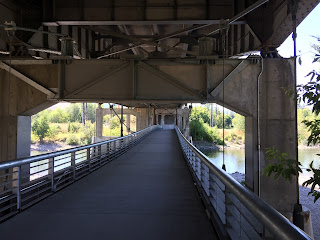We learned a lot about a really special job that uses these tools.
Any ideas what the job is?
How about now?
If that's not enough information, this should help.
All of these are tools used by smoke jumpers. We toured the Smokejumpers Center in Missoula, Montana, and were surprised to learn that smoke jumpers are really good at sewing. They make their own jump suits and parachutes and backpacks. In fact, our tour guide Molly, who is married to a smoke jumper, says she doesn't know anything about sewing. She sends her sewing projects to work with her husband.
Here are the clothes that smoke jumpers wear.
The sky was hazy with smoke as we pulled into the smoke jumpers facility. The smoke was from the first wildfire near Missoula this year.
We learned a lot about the training of smoke jumpers. They must weight at least 120 pounds and no more than 200. Training for new jumpers lasts 5 weeks and includes 20 jumps from the airplane. All candidates are already trained firefighters. There are 300 candidates for the 5 training positions each year. Not everyone successfully completes the training. We learned that 65 smoke jumpers are assigned to the Missoula facility, including 4 women. And nationally, their are 20,000 wild land fire fighters but only 400 smoke jumpers.
Each year smoke jumpers must pass a physical fitness test. The requirements are:
Run 1.5 miles in 11:00 minutes or less.
7 pull-ups.
45 sit-ups.
25 push-ups.
Pack 110 pounds on level terrain in 90 minutes or less.
Smoke jumpers are expected to be able to be fully dressed to jump into a fire area within 2 minutes of a siren calling them to duty. Pilots of the planes taking them to the fire are expected to take no more than 10 minutes from the siren to when the plane is taxiing down the runway with smoke jumpers on board. There is a dormitory right next to the airport runway.
Some, but not all, smoke jumpers are certified parachute packers. Here Molly is standing in front of the shelves of packed parachutes. The jumpers pull together their own supplies, including parachutes and have everything ready to go at their locker when they are on call.
After every assignment, the firefights pick up their parachute from the landing zone--often retrieving it from a tree where they landed--and bring it back to the base. If is carefully examined to make sure it is not damaged before it is repacked. The fire fighters sew on patches where damage has occurred. Molly showed us a patch on this parachute.
After the smoke jumpers are dropped to the fire from about 3000 feet, a second pass by the plane drops cargo for the firefighters, including tools, water and food. In front of the food you see a box of supplies with a parachute attached on the top. Someone in the plane attaches a strap on the parachute to a line, pulls hard on the strap and pushes the box out the door. The parachute opens and the box descends safely, hopefully.


















































